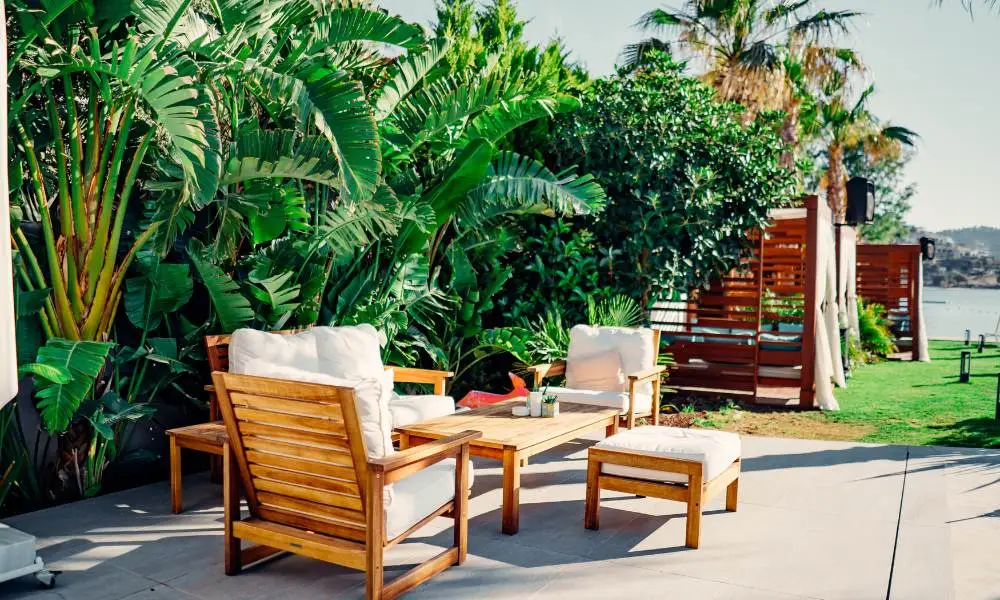When it comes to enhancing the beauty and functionality of your outdoor living space, outdoor furniture that is made from wood stands out as a classic and timeless choice. With its natural aesthetics, durability, and versatility, wooden furniture can transform your patio, garden, or deck into a cozy and inviting haven.
However, choosing the right wooden outdoor furniture can be a daunting task with numerous options available. This buyer’s guide will explore the factors to consider when selecting the perfect furniture, ensuring that you make a wise investment that complements your outdoor space.

Wood Types and Durability
Outdoor furniture that is made from wood comes in various types, each with its unique qualities. It’s important to understand the differences between these wood types and their durability to ensure that your furniture can withstand outdoor conditions. Here are some popular wood options:
Teak – Teak is renowned for its exceptional durability and resistance to moisture and insects. It has a natural oil content that makes it low-maintenance and ideal for outdoor use. Teak furniture can last for decades, but it tends to be on the pricier side.
Cedar – Cedar is another excellent choice, known for its natural resistance to decay and insects. It is lightweight and easy to move, making it suitable for smaller outdoor spaces. However, cedar furniture may require regular sealing to maintain its color and durability.
Redwood – Redwood is a stunning, long-lasting wood with natural resistance to decay and insects. It has a rich, reddish hue that can add a touch of elegance to your outdoor space. Like cedar, redwood furniture may benefit from periodic sealing.
Eucalyptus – Eucalyptus is a sustainable hardwood that offers an affordable option for outdoor furniture. It has natural resistance to decay and insects and, if properly maintained, can last a long time.
Pine – Pine is a more budget-friendly option but is less durable than other woods. To use pine outdoors, it should be treated and regularly maintained to prevent decay and insect damage.
Acacia – Acacia is another cost-effective wood that is great for outdoor wooden furniture.
Style and Aesthetics
The style and aesthetics of your outdoor furniture play a crucial role in enhancing the overall ambiance of your outdoor space. Consider the following factors when choosing the style of your furniture:
Classic vs. Modern – Determine whether you want a classic, timeless look or a more modern and contemporary design. Classic styles often feature intricate details and craftsmanship, while modern designs tend to be sleek and minimalistic.
Matching Existing Décor – If you have existing outdoor décor, such as cushions, umbrellas, or other furniture, ensure that your new wooden pieces complement these elements. Harmonious color and style coordination can create a cohesive and inviting outdoor space.
Functionality – Consider how you intend to use your outdoor furniture. Do you need a dining set, lounge chairs, or a combination of both? Ensure that the furniture you choose fulfills your practical needs while looking good.
Also Read: 8 IKEA Alex Drawer Alternative: The Perfect Solution for Small Spaces
Comfort and Cushions
Comfort is paramount when it comes to outdoor furniture. Even the most beautiful wooden chairs or benches won’t be enjoyable if they’re uncomfortable. Here are some factors to consider for maximum comfort:
Seat Cushions – If your furniture doesn’t come with cushions, you might want to invest in high-quality, weather-resistant cushions. Make sure the cushions are easy to clean and designed for outdoor use.
Ergonomics – Check the ergonomics of the furniture. Does it offer proper back support? Are the seats at a comfortable height? Sit in the furniture if possible to ensure it feels comfortable.
Maintenance Requirements
Outdoor Wooden furniture, while durable, requires some level of maintenance to keep it in top condition. Different wood types have varying maintenance needs, so consider the following:
Sealing and Staining – Many wooden furniture pieces benefit from periodic sealing or staining. This helps protect the wood from moisture and UV rays and maintains its color. Check the manufacturer’s recommendations for the specific type of wood.
Cleaning – Regular cleaning is essential to prevent the buildup of dirt and mildew. A simple mixture of mild soap and water can do wonders. Avoid using harsh chemicals that might damage the wood.
Storage – If your outdoor furniture will be exposed to harsh weather during the off-season, consider storing it in a covered area or investing in covers to protect it from the elements.
Try Before You Buy
Whenever possible, try out the furniture before purchasing it. Sit in the chairs, recline on the loungers, and check for any wobbling or instability. A brief test can help you determine if the furniture meets your comfort and stability standards.
Customization and Accessories
Some manufacturers offer customization options, allowing you to choose the type of wood, finishes, and even specific features to tailor the furniture to your preferences. Consider accessories like umbrellas, outdoor rugs, and side tables to complete your outdoor space.
In conclusion, wooden outdoor furniture can transform your outdoor living space into a beautiful, comfortable, and inviting area for relaxation and entertainment. By considering the wood type, style, comfort, maintenance, budget, sustainability, and other factors discussed in this buyer’s guide, you can make an informed decision that will result in a long-lasting investment.